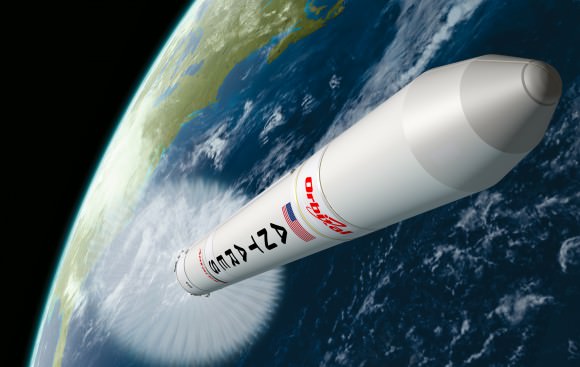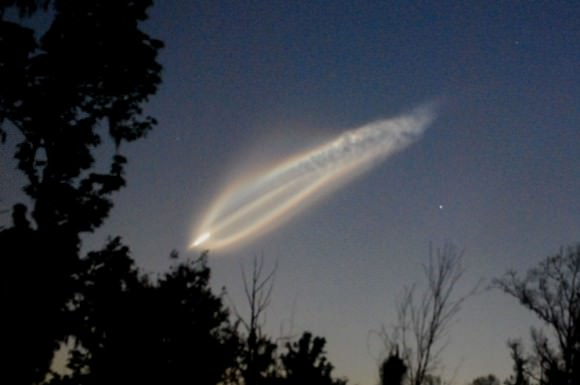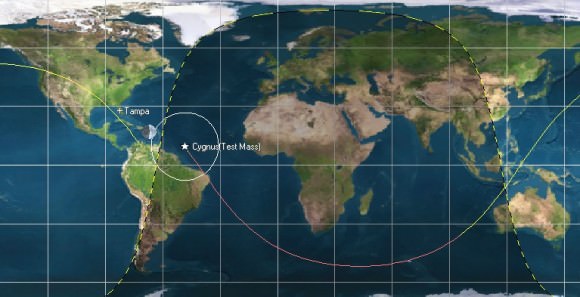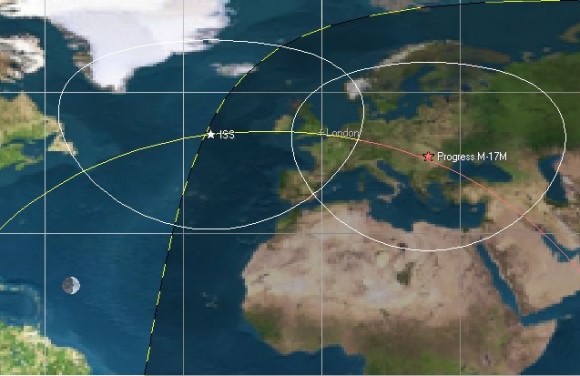A space launch marking a new era is departing from the Virginia coast this Wednesday evening, and if you live anywhere along a wide area of the US Eastern seaboard, you’ll have a great opportunity to witness the launch with your own eyes. Here’s all the information you’ll need to see it, plus some tips for capturing it with your camera.
Orbital Sciences’ Antares rocket will launch from Pad 0A at NASA’s Mid-Atlantic Regional Spaceport based on Wallops Island, Virginia. This will mark not only the first launch of Antares, but the first orbital launch of a liquid-fueled rocket from Wallops. The launch window runs from 5:00 to 8:00 PM EDT (21:00-24:00 UT).
There were some concerns when a technical anomaly shutdown a “Wet Dress Rehearsal” test this weekend at T-16 minutes, but Orbital Sciences has stated that the problems have been resolved and the launch is pressing ahead as planned.
Space shots are a familiar sight to the residents of the Florida Space Coast, but will provide a unique show for residents of the U.S. central Atlantic region. The launch of Antares from Wallops will be visible for hundreds of miles and be over 10° above the horizon for an arc spanning from Wilmington, North Carolina to Washington D.C. and north to the New York City tri-state area as it heads off to the southeast. Antares is a two stage rocket with a 1st stage liquid fueled engine and a solid-fueled 2nd stage. The primary mission for Wednesday’s Antares A-One flight will be to demonstrate the ability for the Antares rocket to place a payload into orbit. If all goes well, Orbital Sciences will join SpaceX this summer in the select club of private companies with the ability provide cargo delivery access to the International Space Station in Low Earth Orbit.

Antares will deploy a dummy mass simulating the Cygnus module. Also onboard are the Phonesat-1a, -1b, and -1c micro-cubesats and the Dove 1 satellite.
Be sure to watch for the launch of Antares if you live in the region. Find a spot with a low uncluttered eastern horizon and watch from an elevated rooftop or hilltop location if possible. I live a hundred miles west of Cape Canaveral and I’ve followed launches all the way through Main Engine Cutoff and first stage separation with binoculars.
Be sure to also follow the launch broadcast live for any last minute delays via NASA TV or Universe Today will have a live feed as well. Antares is aiming to put the Cygnus test mass in a 250 x 300 kilometre orbit with a 51.6° inclination. This is similar to what will be necessary to head to the ISS, but this week’s launch will not be trailing the ISS in its path. This also means that the launch window can be extended over three hours rather than having to be instantaneous.
If the launch goes at the beginning of the window, the local sun angle over the launch facility will be 30° to the west. Sunset at Wallops on the evening of April 17th occurs at 7:41PM EDT, meaning we could be in for a photogenic dusk launch of Antares if it stretches to the end of the target window.
And speaking of which, a pre-sunset launch means short daytime exposure settings for photography. Be prepared to switch over for dusk conditions if the launch extends into the end of the window. Conditions during twilight can change almost moment-to-moment. One of the most memorable launches we witnessed was the pre-dawn liftoff of STS-131 on April 5th, 2010:

Once in orbit, the launch of Antares should generate four visible objects; the test mass payload, the two clam-shell fairings, and the stage two booster. This configuration is similar to a Falcon 9/Dragon launch, minus the solar panel covers. These objects should be visible to the naked eye at magnitudes +3 to +5. The cubesat payloads are tiny and below the threshold of naked eye visibility.
Preliminary visibility for the objects will favor latitudes 0-30° north at dusk to 10-40° at dawn. Keep in mind these predictions could change as the launch window evolves. The next NORAD tracking ID in the queue is 2013-015A. Yesterday’s launch of Anik G1 from Baikonur was just cataloged today as 2013-014A plus associated hardware. The weather is forecast to be 45% “go” for tomorrow’s launch. In the event of a scrub, the next launch window for Antares is April 18-21st.

It’ll be exciting to follow this first flight of Antares and its first scheduled mission to the International Space Station this summer. Also watch for the first ever lunar mission to depart Wallops on August 12 with the launch of the Lunar Atmosphere and Dust Environment Explorer (LADEE).
Finally, if you’ve got a pass of the International Space Station this week, keep an eye out for Progress M-17M currently about 10 minutes ahead of the station in its orbit. The unmanned Progress vehicle just undocked yesterday from the station and will be conducting a series of experiments monitoring the interactions of its thrusters with the ionosphere before burning up on reentry over the South Pacific on April 21st.

The ISS and more can be tracked using Heavens-Above. Also, we’ll be tweeting all of the updates and orbital action as it evolves as @Astroguyz. Let us know of those launch sightings both near and far. It’ll be interesting to see what, if any, impact launches visible to a large portion of the U.S. population will have on the public’s perception of spaceflight. Be sure to look up tomorrow night!


We live north in Delaware it’s overcast here… Will we still be able to see the launch from here?
Really? Seriously?
With the launch headed off to the southeast, even clouds low to the horizon will kill any prospects of seeing the Antares launch… we’ll see when they reschedule it for.